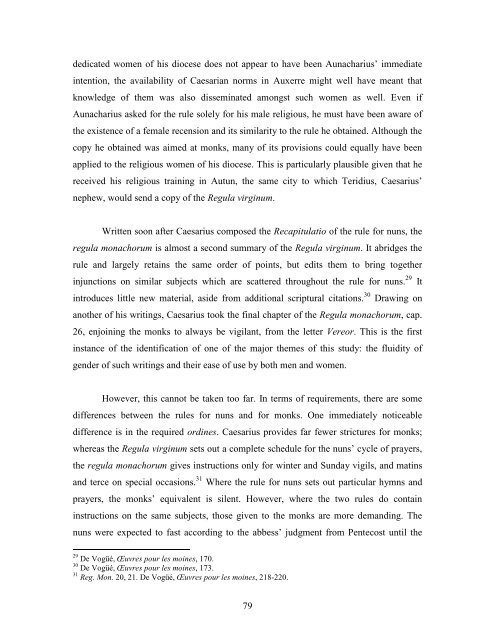Lindsay Rudge PhD Thesis - University of St Andrews
Lindsay Rudge PhD Thesis - University of St Andrews
Lindsay Rudge PhD Thesis - University of St Andrews
Create successful ePaper yourself
Turn your PDF publications into a flip-book with our unique Google optimized e-Paper software.
dedicated women <strong>of</strong> his diocese does not appear to have been Aunacharius’ immediate<br />
intention, the availability <strong>of</strong> Caesarian norms in Auxerre might well have meant that<br />
knowledge <strong>of</strong> them was also disseminated amongst such women as well. Even if<br />
Aunacharius asked for the rule solely for his male religious, he must have been aware <strong>of</strong><br />
the existence <strong>of</strong> a female recension and its similarity to the rule he obtained. Although the<br />
copy he obtained was aimed at monks, many <strong>of</strong> its provisions could equally have been<br />
applied to the religious women <strong>of</strong> his diocese. This is particularly plausible given that he<br />
received his religious training in Autun, the same city to which Teridius, Caesarius’<br />
nephew, would send a copy <strong>of</strong> the Regula virginum.<br />
Written soon after Caesarius composed the Recapitulatio <strong>of</strong> the rule for nuns, the<br />
regula monachorum is almost a second summary <strong>of</strong> the Regula virginum. It abridges the<br />
rule and largely retains the same order <strong>of</strong> points, but edits them to bring together<br />
injunctions on similar subjects which are scattered throughout the rule for nuns. 29 It<br />
introduces little new material, aside from additional scriptural citations. 30 Drawing on<br />
another <strong>of</strong> his writings, Caesarius took the final chapter <strong>of</strong> the Regula monachorum, cap.<br />
26, enjoining the monks to always be vigilant, from the letter Vereor. This is the first<br />
instance <strong>of</strong> the identification <strong>of</strong> one <strong>of</strong> the major themes <strong>of</strong> this study: the fluidity <strong>of</strong><br />
gender <strong>of</strong> such writings and their ease <strong>of</strong> use by both men and women.<br />
However, this cannot be taken too far. In terms <strong>of</strong> requirements, there are some<br />
differences between the rules for nuns and for monks. One immediately noticeable<br />
difference is in the required ordines. Caesarius provides far fewer strictures for monks;<br />
whereas the Regula virginum sets out a complete schedule for the nuns’ cycle <strong>of</strong> prayers,<br />
the regula monachorum gives instructions only for winter and Sunday vigils, and matins<br />
and terce on special occasions. 31 Where the rule for nuns sets out particular hymns and<br />
prayers, the monks’ equivalent is silent. However, where the two rules do contain<br />
instructions on the same subjects, those given to the monks are more demanding. The<br />
nuns were expected to fast according to the abbess’ judgment from Pentecost until the<br />
29 De Vogüé, Œuvres pour les moines, 170.<br />
30 De Vogüé, Œuvres pour les moines, 173.<br />
31 Reg. Mon. 20, 21. De Vogüé, Œuvres pour les moines, 218-220.<br />
79

















